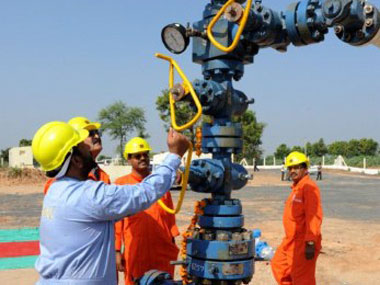ConocoPhillips’ partners in Kazakhstan’s Kashagan field have 60 days to exercise pre-emption rights to prevent ONGC Videsh from buying an 8.4 percent stake in the project held by the US company, the Indian firm’s managing director DK. Sarraf said.
The Kashagan field is jointly controlled by state-run KazMunaiGas and six international companies - ConocoPhillips, Italy’s Eni, ExxonMobil, Inpex Corpof Japan, Royal Dutch Shell , and France’s Total.
According to a CNBC-TV18 report, ConocoPhillips will reach out to its consortium partners for the waiver of per-emtion rights.
Analysts said Shell and Exxon were unlikely to want to exercise their right of first refusal because of the ongoing problems at the project. Inpex, Japan’s biggest energy explorer, which has a 7.56 percent stake in Kashagan, said it couldn’t comment on the move by ONGC or whether it was offered the stake by ConocoPhillips.
ConocoPhillips has said it aims to sell its stake in the Kashagan field, the world’s biggest oilfield discovery since 1968, for about $5 billion to ONGC Videsh, the overseas investment arm of Oil and Natural Gas Corp.
DK. Sarraf, Managing Director, OVL, said Kazakhstan government has six months to approve the deal after the expiry of a 60-day period for the partners to express their right of first refusal. “The deal has to be approved within 240 days,” Sarraf said.
With ONGC’s domestic output flat for years, India now buys nearly 80 percent of its oil needs and is the world’s fourth-biggest oil importer. It is under pressure from the government to meet rising demand.
Impact Shorts
More Shorts“We can bring it (the oil) to India, and other options are also there. There is a CPC pipeline and some pipelines are coming from Russia,” Sarraf said, referring to the Caspian Pipeline Consortium facility. “We will look at all options, including selling it on spot markets.”
ONGC has a 20 percent stake in Russia’s Sakhalin-1 project, operated by ExxonMobil, and normally sells its equity oil through spot tenders.
Sarraf said a deal may be funded through a mix of loans from ONGC and overseas borrowings. “We have yet to finalise the funding plan,” he said.
In an interview to CNBC-TV18 he, however, said that the funding plan for the OVL buy is not yet firmed him. “It is very possible that we will give a loan o OVL for the acquisition, but it is too early to say what debt equity mix will be utilised for the buys.
The acquisition would likely add 1 million tonnes (20,000 barrels per day) to ONGC Vidhesh’s annual production over 25 years, with its share of output significantly higher in later stages of development.
“We have a target of 20 million tonnes of oil and gas production by 2017-18 and 60 million tonnes by 2029-30, and today our production is less than 9 million tonnes. This would help us bridge the gap to an extent and help in energy security,” Sarraf said.
[caption id=“attachment_536964” align=“alignleft” width=“380”]  Deal may be funded through a mix of loans from ONGC and overseas borrowings.[/caption]
ONGC is also not expecting any hurdles in getting approvals from the CCEA for the deal as it has done a thorough due diligence and is satisfied with the valuations.
ConocoPhillips, which has been shedding overseas assets to cut debt and increase its investment in lower-cost domestic shale oil and gas, said on Monday the book value of assets related to its Kashagan interest was about $5.5 billion as of end-September, and it would take an after-tax impairment of about $400 million.
ONGC Videsh, which holds a 25 percent share in the Satpayev block in Kazakhstan, owns stakes in assets in more than a dozen countries - including Myanmar, Vietnam, Sudan, South Sudan, Russia, Azerbaijan, Syria, Libya, Brazil, Colombia and Venezuela.
ONGC shares, valued at more than $38 billion, traded around 1 percent higher mid-Tuesday - moving up from a near-6 month low hit on Friday.
With inputs from Reuters


)

)
)
)
)
)
)
)
)



